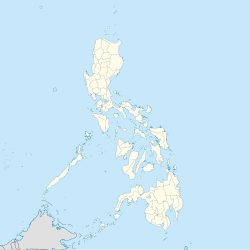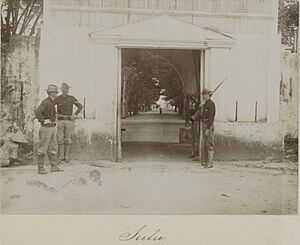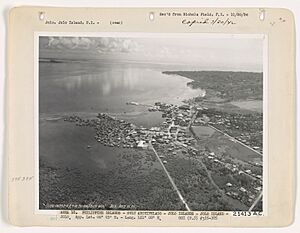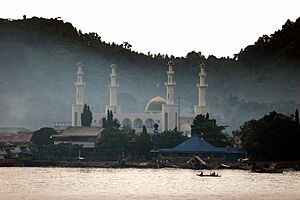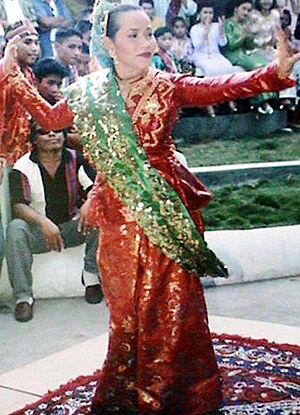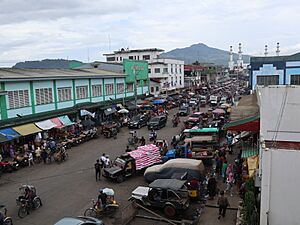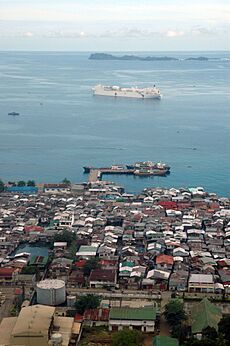Jolo, Sulu facts for kids
Quick facts for kids
Jolo
Tiyanggi
Tausug: تِیَڠْگِ |
|||
|---|---|---|---|
| Municipality of Jolo | |||
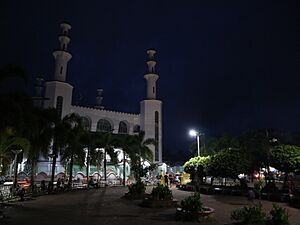
Tulay Central Mosque
|
|||
|
|||
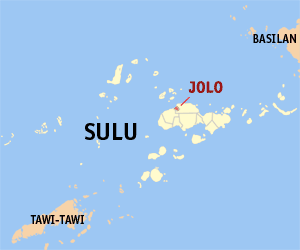
Map of Sulu with Jolo highlighted
|
|||
|
OpenStreetMap
|
|||
| Country | Philippines | ||
| Region | Zamboanga Peninsula | ||
| Province | Sulu | ||
| District | [[{{#property:P7938}} | — Lua error in Module:Wd at line 1804: attempt to index field 'wikibase' (a nil value).]] | ||
| Established | February 11, 1904 | ||
| Barangays | 8 (see Barangays) | ||
| Government
|
|||
| • Type | Sangguniang Bayan | ||
| Area | |||
| • Total | 22.24 km2 (8.59 sq mi) | ||
| Elevation | 70 m (230 ft) | ||
| Highest elevation | 430 m (1,410 ft) | ||
| Lowest elevation | 0 m (0 ft) | ||
| Population
(2020 census)
|
|||
| • Total | 137,266 | ||
| • Density | 6,172.0/km2 (15,985/sq mi) | ||
| • Households | 20,354 | ||
| Economy | |||
| • Income class | 1st municipal income class | ||
| • Poverty incidence |
|
||
| • Revenue | ₱ 421.6 million (2022) | ||
| • Assets | ₱ 173.3 million (2022) | ||
| • Expenditure | ₱ 415.2 million (2022) | ||
| • Liabilities | ₱ 32.09 million (2022) | ||
| Service provider | |||
| • Electricity | Sulu Electric Cooperative (SULECO) | ||
| Time zone | UTC+8 (PST) | ||
| ZIP code |
7400
|
||
| PSGC |
[https://psa.gov.ph/classification/psgc/?q=psgc/barangays/{{#pro000®code={{&provcode=
|
||
| IDD : area code | +63 (0)68 | ||
| Native languages | Tausug Sama Yakan Sabah Malay |
||
| Website | www |
||
Jolo is a town and the capital of the Sulu province in the Philippines. It is officially known as the Municipality of Jolo. In 2020, about 137,266 people lived there.
Contents
What's in a Name?
The name Jolo comes from the old Spanish spelling of Sulu. Long ago, the Spanish pronounced it like "sho-lo," but later it changed to "ho-lo." The word Sulu itself comes from the Tausug word Sulug, which means "sea current."
A Look Back in Time
Early Days
In the 1300s, Arab traders arrived in Jolo. They introduced Islam to the people living there. The main group of people on the island are called the Tausūg people. They are part of a larger group called the Moro people.
The Moro people had their own independent state called the Sultanate of Sulu. Jolo was the main center for this Sultanate, where the Sulu Sultans lived.
Spanish Rule
The Spanish tried to take control of the Muslim areas in Mindanao, but they found it hard. They had already taken over islands in the north, but the well-organized sultanates in the south were difficult to conquer.
Jolo as a Trading Hub
The Sultanate of Sulu was a busy trading center. It traded with nearby places and even with countries like China. They often bought rice from the northern Philippines because Jolo didn't grow enough.
Chinese Traders Arrive
Since the 1400s, the Sulu Sultanate traded with many countries by sea. A lot of trade happened with Singapore. In the 1870s, Chinese traders started to take over much of the trade in Jolo. Many Chinese came from the Fujian province and worked as craftsmen or laborers. They learned the Malay language and became skilled in trading with people in Southeast Asia. These Chinese traders became very important in Jolo's economy.
Some Chinese in Sulu also helped supply weapons to the Moro leaders (Datus and Sultans) to fight the Spanish. They traded goods for these weapons. The Chinese created a big trading network connecting Singapore, Zamboanga, and Jolo.
In 1887, the Spanish attacked the Sultanate's capital, Maimbung, to stop the resistance. They took weapons and sent the Chinese traders back to Jolo.
Spanish Control Grows
In 1876, the Spanish managed to burn Jolo and gain some control. In 1877, Spain, England, and Germany signed an agreement called the Sulu Protocol. This agreement recognized Spain's rights over Sulu. The Spanish also built a small walled city in Jolo. In 1878, the Sultan of Sulu agreed to Spanish rule over Sulu and Tawi-Tawi, but the Spanish only controlled military bases and some settlements.
Trade Slows Down
Trade in Jolo suffered a lot in 1892 when three trading ships were lost in storms. Traders in Singapore became careful and only accepted cash payments. Many Chinese traders left Jolo, and the town lost its important role as a regional trading hub.
American Rule
After the Treaty of Paris (1898) in 1898, the United States took over the Philippines from Spain. The Americans tried to include the Muslim areas into the Philippine state. They used force to take control of the southern regions in what was called the Moro Rebellion. The Sultanate of Sulu was officially ended in 1936.
Becoming Independent
In 1974, Jolo was taken over by members of the Moro National Liberation Front. The Philippine Army then surrounded the city in the Battle of Jolo (1974). The city was badly damaged during this time.
Jolo's Location and Nature
Jolo town is on the northwest side of Jolo Island. This island is southwest of the Zamboanga Peninsula on Mindanao island. It sits between the provinces of Basilan and Tawi-Tawi. The Sulu Sea is to its north, and the Celebes Sea is to its south.
Jolo is a volcanic island that covers about 890 square kilometers. It's in the middle of the Sulu Archipelago, which is a chain of about 900 islands. These islands are made from volcanoes and coral. The last known volcanic activity near Jolo was an earthquake in 1897, which caused big tsunamis.
Town Divisions
Jolo is divided into 8 smaller areas called barangays. Each barangay has even smaller parts called puroks and sometimes sitios.
- Alat
- Asturias
- Bus-Bus
- Takut Takut
- Tulay
- San Raymundo
- Chinese Pier
- Walled City
Weather in Jolo
Jolo has a very warm, humid, and wet tropical rainforest climate. It rains a lot throughout the year.
| Climate data for Jolo, Sulu | |||||||||||||
|---|---|---|---|---|---|---|---|---|---|---|---|---|---|
| Month | Jan | Feb | Mar | Apr | May | Jun | Jul | Aug | Sep | Oct | Nov | Dec | Year |
| Mean daily maximum °C (°F) | 27 (81) |
27 (81) |
27 (81) |
28 (82) |
28 (82) |
28 (82) |
28 (82) |
28 (82) |
28 (82) |
28 (82) |
28 (82) |
28 (82) |
28 (82) |
| Mean daily minimum °C (°F) | 27 (81) |
26 (79) |
27 (81) |
27 (81) |
28 (82) |
28 (82) |
27 (81) |
27 (81) |
27 (81) |
27 (81) |
27 (81) |
27 (81) |
27 (81) |
| Average rainfall mm (inches) | 170 (6.7) |
130 (5.1) |
125 (4.9) |
122 (4.8) |
229 (9.0) |
286 (11.3) |
254 (10.0) |
248 (9.8) |
182 (7.2) |
257 (10.1) |
233 (9.2) |
188 (7.4) |
2,424 (95.5) |
| Average rainy days | 18.3 | 15.3 | 15.2 | 14.6 | 22.8 | 24.0 | 24.3 | 23.3 | 20.5 | 22.6 | 21.9 | 19.3 | 242.1 |
| Source: Meteoblue (modeled/calculated data, not measured locally) | |||||||||||||
People of Jolo
Population Changes
Languages Spoken
Most people in Jolo speak Tausug. English is also used, especially in schools and offices. Some traders speak Hokkien and Malay. Other languages include Sama and Yakan.
Religions in Jolo
About 99% of the people in Jolo are Muslim. There is also a group of Christians, including Roman Catholics and Protestants. The Tausugs were among the first Filipinos to become Muslim. This happened when a Muslim missionary named Karim ul-Makhdum came to Sulu in 1380.
The Tulay Central Mosque is the biggest mosque in Jolo and in the province. There are many other mosques around town. The Our Lady of Mount Carmel Cathedral is the largest Catholic church in Jolo. The Jolo Alliance Evangelical Church was the first Protestant church in the area, starting in the 1900s.
Culture and Traditions
The Moro people are the main group in the Southwest Philippines, and Jolo is their homeland. Most people in Jolo are Tausugs. The word Tausug means "people of the current," because they were known as skilled seafarers and traders. They are also known as a warrior tribe.
Before they became Muslim, Tausugs lived in communities led by datus (chiefs). They followed a strict set of traditional laws called Adat.
Tausug art and crafts show a mix of Islamic and Indonesian styles. The Pangalay is a popular dance performed at Tausug weddings, which can last for weeks! They dance to music from instruments like the kulintangan and agong. Another dance, Pangalay ha Agong, is a courtship dance where two warriors compete for a woman's attention using a large brass gong.
Many people in Jolo have Chinese family roots. Between 1770 and 1800, about 18,000 Chinese came to trade, and many stayed.
Jolo's Economy
Poverty Incidence of Jolo
| Lua error in Module:Chart at line 302: bad argument #1 to 'max' (number expected, got string).
Source: Philippine Statistics Authority |
Main Industries
Most people in Jolo work in agriculture. They grow crops like coconut, cassava, abaca, coffee, lanzones, jackfruit, durian, mangosteen, and marang. Fishing is also a very important industry. Other jobs include building boats, weaving mats, processing coffee, and making fruit preserves.
Banks and Money
Several banks operate in Jolo, helping people with their money needs. These include the Philippine National Bank, Metrobank, and Land Bank. You can also find ATMs at some bank branches.
Growing the Economy
Economic growth in Jolo has been difficult because of conflicts and unrest caused by some groups. These issues have made these Muslim-majority islands some of the poorest areas in the country. However, the situation has gotten better, especially since 2024. This is due to help from other countries and increased security from the Philippine authorities.
Organizations like the United States Agency for International Development (USAID) have funded projects to help Jolo. For example, they helped build a road to make it easier for farmers to sell their crops. In 2007, the US Ambassador announced plans to improve the Jolo Airport.
The Philippine government has also spent money on development and infrastructure in Sulu. In 2008, a project began to improve Jolo's water supply system.
Safety and Community Life
Family Conflicts
In Sulu province, there are sometimes conflicts between different families or clans. These conflicts often start over land or disagreements. Many households own guns, and families sometimes use violence to settle disputes. This makes it hard for the police to keep order.
In 2008, a "Zone of Peace" was set up in Jolo. In this zone, firearms were restricted to help solve family conflicts peacefully. The local government is trying to expand this idea to other areas.
Local Challenges
The island was once considered unsafe for foreigners. However, the situation has improved, especially with development projects helping the community.
There have been some serious incidents in Jolo.
- 2019 Cathedral Bombings: On January 27, 2019, two bombings happened at the Cathedral of Our Lady of Mount Carmel. Many people in Jolo spoke out against these attacks.
- 2020 Town Plaza Bombings: On August 24, 2020, a bomb exploded in front of the Paradise Food Plaza. Later, a second bomb exploded near the Cathedral of Our Lady of Mount Carmel. These attacks caused deaths and injuries.
Jolo's Importance
The Moro people live mainly in the Southwest Philippines. They feel a strong connection to nearby Muslim nations like Indonesia and Malaysia because of shared culture and language. For over 400 years, the Moro people have sought their own independent state.
Jolo has been a key place in this long struggle. Between 1972 and 1976, Jolo was at the center of a conflict between Muslim groups and the government. In 1974, fighting broke out when government troops stopped the Moro National Liberation Front (MNLF) from taking over the town.
Today, the Moro National Liberation Front is the ruling party in the Autonomous Region in Muslim Mindanao (ARMM). In 1996, the MNLF was given leadership of the ARMM to give Muslims more self-rule. Local politicians often gain power with the help of their family connections.
See also
 In Spanish: Joló para niños
In Spanish: Joló para niños
- Battle of Jolo (1974)




